AMD's Radeon HD 6790: Coming Up Short At $150
by Ryan Smith on April 5, 2011 12:01 AM ESTPower, Temperature, & Noise
Last but not least as always is our look at the power consumption, temperatures, and acoustics of the Radeon HD 6790. Our power usage data should closely mirror any other 6790, but given the unique design of our card versus what AMD’s partners are going with, we can’t fully account for all the different designs.
On that note, at this point we do not know what the 6790’s default voltage is. None of our usual low-level tools recognize the 6790; it’s possible that AMD is using different controllers than on the 6800 series, or perhaps it’s related to drivers. In any case we believe it’s close to the 6870’s voltage of 1.17v, but we can’t measure it at this time.
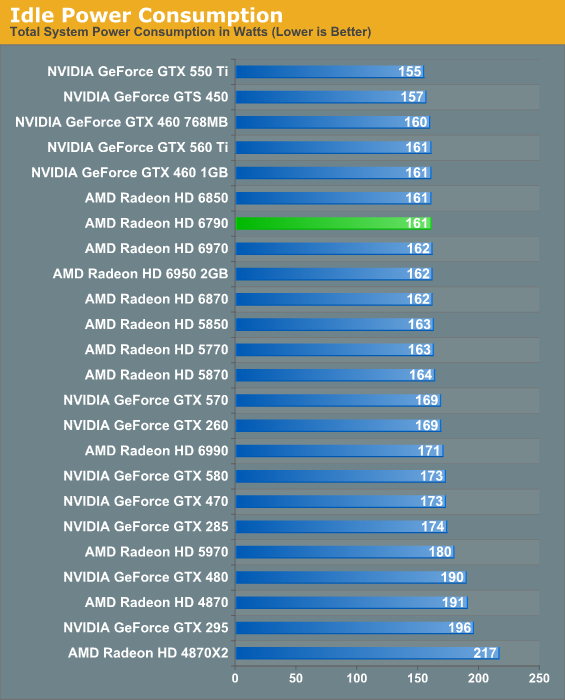
Idle power consumption rarely changes among the different tiers of a GPU, so the fact that the 6790 pulls almost as much power at idle as the 6800 series should not come as a surprise. It does end up being worse than the GTX 550 Ti, but almost exactly alike the GTX 460.
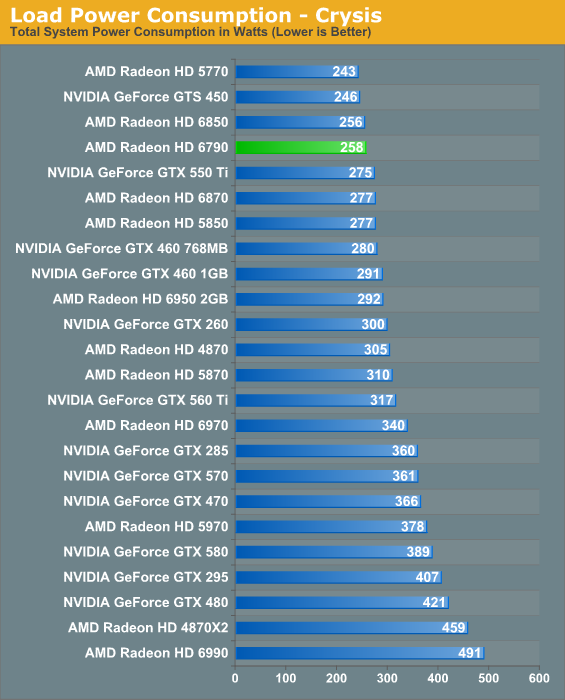
Given AMD’s TDP numbers, we were expecting our power results to closely shadow our 6870 results. Instead we had a pleasant surprise: power consumption under Crysis is higher than the 6850, but not significantly so. In fact it’s still below the GTX 550 Ti even though it significantly outperforms said video card on this game, and even compared to the 5770 it’s not significantly worse for the 6790’s performance advantage. Not that it’s great to be consuming more power than a 6850 for less performance, but it could very well have been worse.
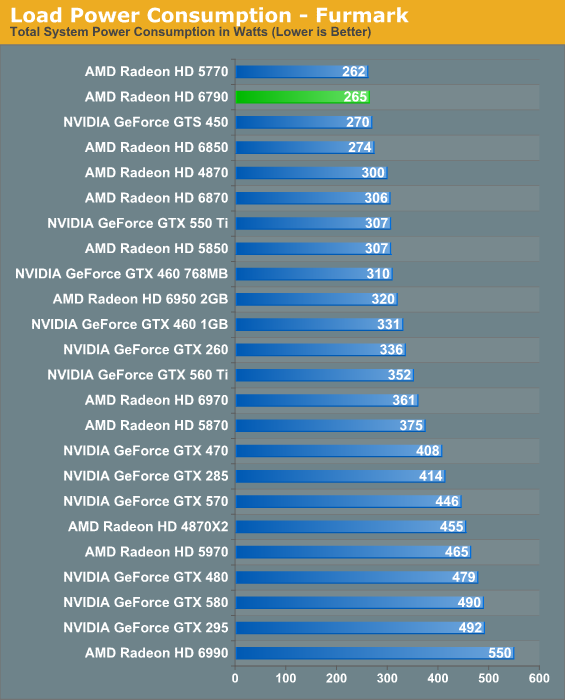
The situation under Furmark is even better surprisingly enough. The 6790 consumes less power than the 6850 here – not a ton less, but less. Perhaps more surprising is that compared to the 5770 it’s only consuming 3W more; this Barts chip may have a lot of functional units disabled, but that’s still quite remarkable, and is all the more proof of the optimizations AMD made for Barts compared to Cypress. This also makes it look exceptionally good versus the GTX 550 Ti and GTX 460 768MB, as it’s consuming 40-45W less.

With idle power consumption being identical to the 6800 series and using the same cooler, the idle temperature is similarly close.
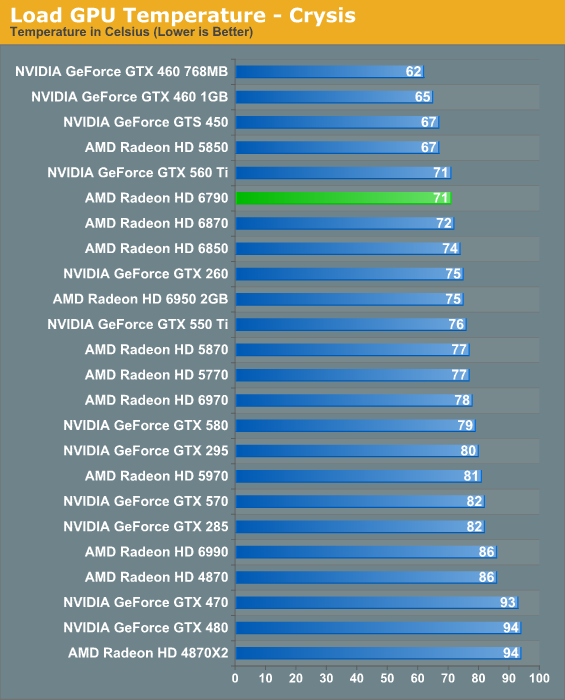
Given the power numbers we saw earlier, the 6870’s cooler ends up being overkill for the 6790. As a result Crysis temperatures are quite low, although the fully exhausting cooler can’t keep up with the open cooler of the GTX 460. Then again our 5770 is an open cooler, and it’s still much warmer. Keep in mind that this is going to highly vary with the design of the cooler the partner uses though.
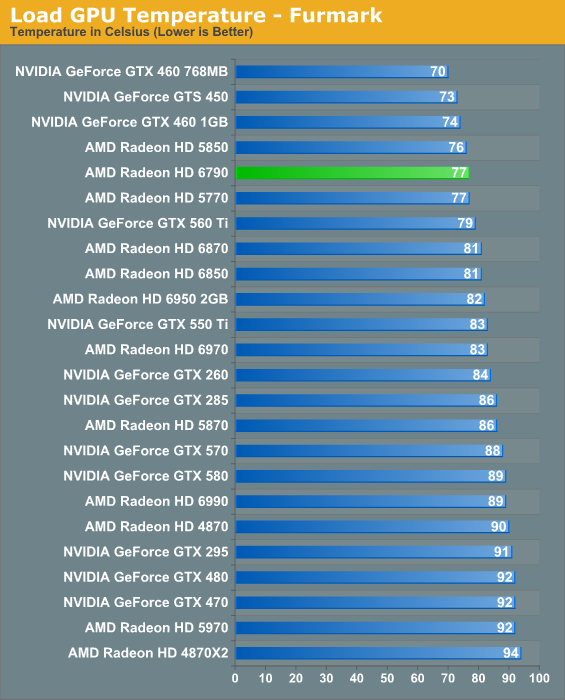
Temperatures under Furmark closely trend Crysis. An open cooler might be able to get the 6790 down to the low 70s.
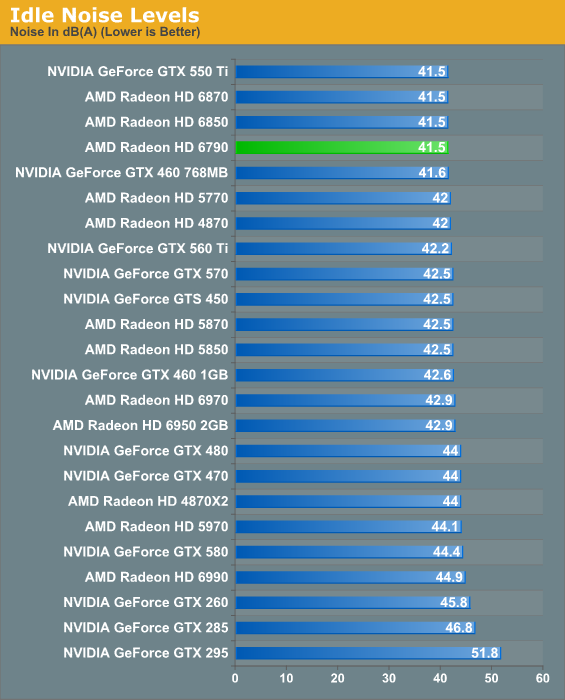
Idle noise is identical to the 6800 series, as we’d expect.
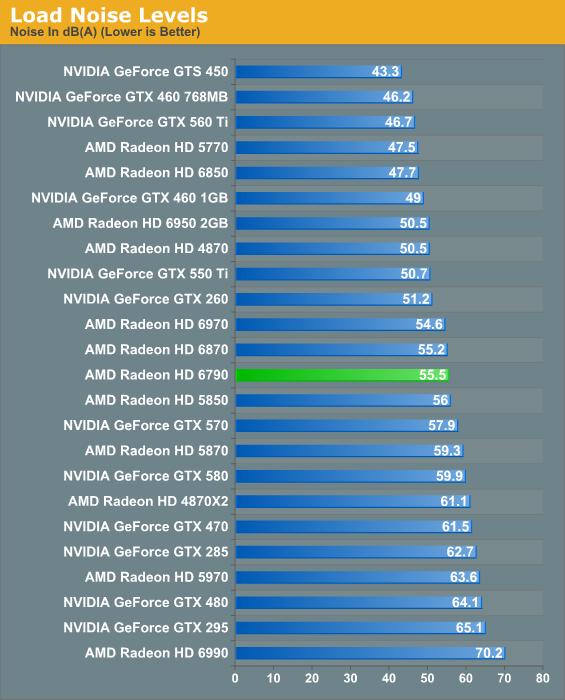
Load noise is where the wheels begin to fall off on our 6790 sample. The card does so well with regards to power consumption and temperature, but noise is just as bad as the 6870. This undoubtedly is due to how AMD tweaked the 6790 engineering sample – which is to say it likely hasn’t been optimized much if at all since it won’t go into production. Given the power data we’ve seen the 6790 doesn’t need to be much louder than a 6850, so hopefully partner cards will reflect this. If not, the worst case scenario may very well be having all the noise of a 6870 and not nearly the performance.










69 Comments
View All Comments
Amoro - Tuesday, April 5, 2011 - link
I'm pretty sure that only Cayman is VLIW4.Ryan Smith - Tuesday, April 5, 2011 - link
Correct. NI is a very broad family; it doesn't definite a single architecture. Cayman is VLIW4, Barts, Turks, and Caicos are VLIW5 and are basically optimized versions of Evergreen (5000 series) hardware.http://www.anandtech.com/show/3987/amds-radeon-687...
Amoro - Tuesday, April 5, 2011 - link
If you look at some of the raw performance specifications for the two cards it seems to indicate that texture fillrate and raw processing power don't have as much of an impact on Anandtech's testing suite.Radeon HD 5830
Fillrates
12.8GP/s
44.8GT/s
Memory Bandwidth
128GB/s
GFLOPS
1792
Radeon HD 6790
Fillrates
13.4GP/s
33.6GT/s
Memory Bandwidth
134.4GB/s
GFLOPS
1344
The 6790 wins in pixel fillrate and memory bandwidth but loses horribly in raw processing power and texture fillrate yet it still manages to keep within -10% and even manages to beat the 5830 in some cases.
BoFox - Wednesday, April 6, 2011 - link
Thanks for some more of those numbers!We can see that the 5830 has far higher numbers in these areas:
44.8 GT/s
1790 GFLOPs
And the 6790 has only
33.6 GT/s
1344 GFLOPs
While the 6790 has greater pixel fillrate and memory bandwidth than the 5830.
If it were not for VLIW4, why is the 5830 only 2-3% faster than 6790 in this review here, if you look at all of the benchmarks? Why?
Another way we could find out is to see how much it affects DP performance in applications like Milkyway@home. Cards with VLIW4 should have 1/4 the FP64 output ratio to FP32 output, so I wouldn't be surprised if we see 6790's being 20% faster than the similarly spec'ed 4890.
BoFox - Thursday, April 7, 2011 - link
Ahh, your article reminded me that FP64 was disabled for Barts GPUs.. I must've forgot about it and wanted to test it to prove that it's VLIW4.But the numbers in the replies below strongly point to the 6790 being boosted by VLIW4 in order to basically match up to a 5830 with 40% more shaders and TMU's.
Any explanation for this, sir Ryan?
BoFox - Friday, April 8, 2011 - link
RE: "From a graphics point of view it's not possible to separate the performance of the ROPs from memory bandwidth. Color fill, etc are equally impacted by both. To analyze bandwidth you'd have to work from a compute point of view. However with that said I don't have any reason to believe AMD doesn't have a 256-bit; achieving identical performance with half the L2 cache will be harder though."1) If it's not possible to separate the performance from a "graphics" rather than "compute" point of view, then should not the performance be linked for all "graphics" point of views (as it is a "graphics" card to begin with)? Even the "compute" applications (FP16 and FP32 analysis at http://www.behardware.com/articles/783- ... -5830.html ) show the card to behave like as if it's 128-bit.
2) Why does Ryan not have any reason to believe.. because AMD said so? If a manufacturer of a LCD panel advertises 1ms G2G response time, but it looks like 16ms, does he still have no reason to believe it's 16ms just because the manufacturer said so?
3) If the L2 cache is cut down in proportion with the castrated shaders/TMUs/ROPs, then it should not affect performance, let alone "harder though".
Soldier1969 - Tuesday, April 5, 2011 - link
2 x 6970s FTW at 2560 x 1600 res.JimmiG - Tuesday, April 5, 2011 - link
Is it just me or is all this talk about price difference of $10 or less getting a little ridiculous? I mean, if you're prepared to spend $150 (or $160...) on something that is completely non-essential, what difference is $10 going to make? If you're so poor that $10 is a big deal, you're probably not spending your money on gaming products anyway since you need everything for stuff like food and rent.It seems the video card companies are the guilty ones, constantly trying to outmaneuver each other with new pricing schemes. I miss the old days when there was one $100 card, one $200 card, one $300 card etc. Now there can easily be a dozen different models in the range of $100 - $300.
liveonc - Tuesday, April 5, 2011 - link
This looks like a prime candidate for a mini-ITX for those who'd want a desktop replacement, but don't want to pay so damn much for something that has 30minutes of battery life, doesn't have a chance to outperform a desktop, & costs too much.lorribot - Tuesday, April 5, 2011 - link
Might be just me but since the 4000 series i dont actually understand AMDs numbering scheme anymore.There seem to be a great variety of of 6000 cards all with very similar performance and different prices.
There is the 6990 at the top then a couple more 69xx cards then some 68xx and some 67xx, all well and good but it seems the 5870 is faster card then the 6870, which is odd and not what i would have expected, indeed it has similar performance to the 5850.
The 5xxx series came in 53, 54, 55, 56, 57, 58 and 59 flavours with one, two or three sub versions in each band giving something like 15 or 16 different cards.
It seems to me that with so many variations and a numbering scheme that seems to change from version to version AMD seem to actually want to confuse the buying public.
They really need to get a handle on this, less is more in some cases.
Nvidia's numbering scheme on the whole seems to be much more sensible in recent times, apart from the odd hiccup with 460 and 465.